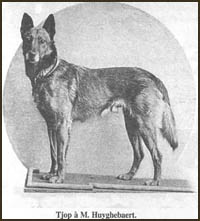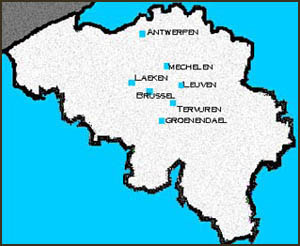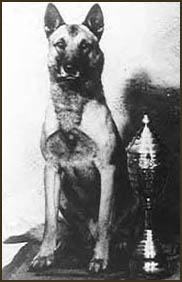HISTORY OF MALINOIS
 From
the beginning of man, dogs played an important role in our lives. Wolves,
as ancestors to our dogs, were caught and raised with man, and in return
for food and shelter they were used for hunting and protection. As the
living environment of man changed, so did the tasks of their dogs. There
were dogs for hunting, protection of the home and family, carrying loads,
and for driving and guarding cattle and sheep. The shepherd-type dog was
now coming into creation.
From
the beginning of man, dogs played an important role in our lives. Wolves,
as ancestors to our dogs, were caught and raised with man, and in return
for food and shelter they were used for hunting and protection. As the
living environment of man changed, so did the tasks of their dogs. There
were dogs for hunting, protection of the home and family, carrying loads,
and for driving and guarding cattle and sheep. The shepherd-type dog was
now coming into creation.
Depending
on many factors, the size, color, and hair type of the shepherd-dogs varied
quite a bit. In colder climates, the dogs needed a thicker, longer coat,
and in milder climates a shorter coat sufficed. Big strong dogs were needed
in areas where there were numerous predators. In areas where the bears,
wolves and wild cats had been driven away by humans, smaller dogs with
a lighter build
were kept. In Belgium, The Netherlands, Germany and France, the industrial
and urban areas grew much faster than in the east European countries.
With that, the tasks and looks of the dogs in western Europe became very
different from those in Eastern Europe. By the end of the nineteenth century
there were quite a few shepherd dogs in Belgium that were of a similar
type.
They had a similarly nice temperament, and were very energetic and
spirited. They were also very friendly toward their shepherds, but mistrusting
and aloof toward strangers. The dogs were well adjusted to the wet and
windy Belgian climate. Their build was ‘square’ (= the distance
measured from the top of the withers to the ground is the same as the
distance from the withers to the croup, or beginning of the tail) the
ears were erect, triangular, and implanted high on the head, and the eyes
were dark and almost almond shaped. They had a lively and intelligent
expression, and weren’t very heavily boned. The differences in appearance
were however, quite large. They were above all working dogs that had a
task to perform, and were hardly ever owned by people interested in conformation.
Eventually, there would be four varieties of Belgian Shepherds; the Groenendaeler
(called the Belgian Sheepdog in the US) the Tervuren, the Lakenois, and
the Malinois. In the beginning, the Malinois was simply referred to as
the shorthaired type. It seemed that around Mechelen/Maline and the area
north of Antwerp all the way into the Noord Brabant region of the Netherlands,
a lot of shorthaired shepherd dogs of the same type were found. In 1892,
at an agricultural exposition in Oosterhout, The Netherlands, which was
just across the border from Belgium, no less than 12 dogs of the same
Belgian type and belonging to farmers were shown. They varied in size,
from that of a fox to that of a wolf, and had short hair colored in different
shades of red. Their ears were remarkably erect and pointed, and they
had a fine triangular muzzle with a black nose. The tail was shaped like
an ear of wheat and carried horizontally with the tip being a little higher
than the rest of it.

A
club was formed in Maline/Mechelen, Belgium, to improve the shorthaired
Belgian Shepherd. They clearly preferred a dog that could perform a task
rather than focusing on the looks. The typical sheepdog trials were replaced
by t
Tjop
ests that had as goal to test the intelligence, obedience and loyalty
of the dogs rather than focusing on herding sheep, a task that was slowly
disappearing due to industrialization. After a brochure was published
by the club from Maline about the shorthaired Belgian, the name soon changed
to "Malinois" or "Mechelaar".
One of the members of the club, Frantz Huijgebaart, had a dog named Tjop.
His father was Tomy, the mother was Cora van Optewel. Tjop had a beautiful
structure, was 57 cm high and a good color, but lacked the black mask.
He was a good working dog except for being very nervous. Tomy gave him
a typical head, perfect ears and a well carried tail. His look, intelligence,
long back, finely boned legs, and rough hair above the tail came from
his mother.
Dewet was a dog that belonged to the Mairesse brothers. His father was
Vos and his mother was Mouche. Dewet was a beautiful dog, well built and
with a beautiful coat, remarkable shoulders, chest, and back. He had a
good head, carried his tail perfectly, and had small, triangular ears.
A nervous and expressive dog, Dewet's largest fault was his pale color.
He did, however, have a black mask and dark shoulders.
The
ideal was a dog having pale red on all parts of the body, black hairtips
on the back and around the neck, and a solid black tailtip. The red is
supposed to get lighter toward the flanks and legs but without a visible
border. There is a definite border on the muzzle and ears that should
be black. The lower part of the body is covered with paler hair. The gene,
responsible for the black mask, is also responsible for the black ears
and a triangle halfway down the tail, as well as the black tailtip. In
1900 the two dogs produced, Tjop and Dewet, were both beautiful but very
different, and a real battle broke out over them. They can be considered
as the forefathers of the Malinois since either, or both, of these names
can be found in the beginning of almost all Malinois pedigrees.
 THANKS
TO JUDITH AT SEVEN
PINES FOR LETTING ME
THANKS
TO JUDITH AT SEVEN
PINES FOR LETTING ME
BORROW HER STORY
 From
the beginning of man, dogs played an important role in our lives. Wolves,
as ancestors to our dogs, were caught and raised with man, and in return
for food and shelter they were used for hunting and protection. As the
living environment of man changed, so did the tasks of their dogs. There
were dogs for hunting, protection of the home and family, carrying loads,
and for driving and guarding cattle and sheep. The shepherd-type dog was
now coming into creation.
From
the beginning of man, dogs played an important role in our lives. Wolves,
as ancestors to our dogs, were caught and raised with man, and in return
for food and shelter they were used for hunting and protection. As the
living environment of man changed, so did the tasks of their dogs. There
were dogs for hunting, protection of the home and family, carrying loads,
and for driving and guarding cattle and sheep. The shepherd-type dog was
now coming into creation. 
 THANKS
TO JUDITH AT
THANKS
TO JUDITH AT